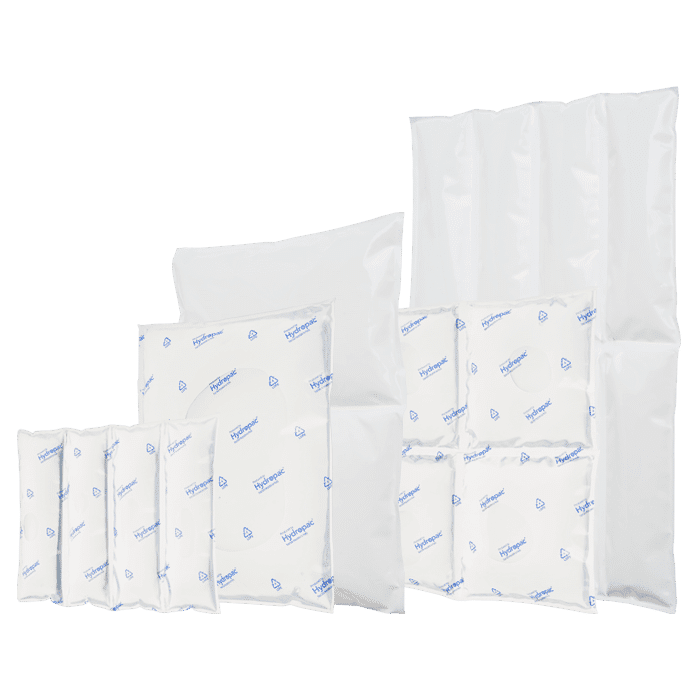Sending foodstuffs within the EU
Updated in 2023 to take new EU shipping rules into account. The original post was published in April 2020.
When shipping food there are a lot of factors that need to be taken into consideration to make sure that packages arrive quickly, efficiently and undamaged. We play our part with our range of tough, highly effective temperature controlled shipping systems, but you need to make sure you tick all your boxes too!
Custom chilled solutions for you
Hydropac offers every customer a customized solution for chilled and conditioned shipping. For example, we help a customer with limited freezing capacity to deliver gel packs frozen and ready to use, and we can manufacture almost all shapes and sizes of cooling elements. As a customer, you come first: we are here to help you.
The do’s and don’ts of sending food packages abroad
Licensed businesses working in consumer products can send a range of different foods abroad if they follow the safety packaging, labelling and importation regulations of the country they are sending the products to. There must be the required certificates in place and food items should be packed efficiently for shipping.
There are different regulations that apply as to what you can send internationally to countries like the United States and Australia, but as a continent, countries in Europe all follow the same general guidelines.
European regulations for sending foodstuffs abroad
There are certain regulations that need to be followed when a business is packaging and sending food or drink products within the EU. Pre-Brexit completion, there were no customs checks for food between the UK and the EU. However, at present time, there is a GB-EU border in place with customs formalities that have to be adhered to.
Why is this now the case?
This border and customs checks were implemented to ensure that all tariffs/duties on food going between Great Britain and the EU are being paid. As the UK is no longer part of the Customs Union and the single market, the same customs rules, standards and enforcement mechanisms do not apply.
Border checks for foodstuffs
Different requirements now apply for foodstuffs, although these do vary depending on the type of goods being moved, where they cross and who is in control of transporting them. That being said, the UK Government has yet to announce a complete and finalised set of border arrangements, with delays having happened already multiple times. The plan is for these to be in place by 2024.That being said, there are some definite requirements in place for human food products. These do vary by type.
Processed food and drink
Processed food and drink items such as cereals, breads, tinned goods, ready meals or savoury snacks will require an Export Health Certificate (EHC) if they contain POAO (Products of Animal Origin) – see below. If they do not contain any POAO, then they do not normally need a EHC. It is best to check if you aren’t sure.
If any processed drinks contain added sugar, you should register for the Soft Drinks Industry Levy, aka the “Sugar Tax”. This was introduced in 2018 to try and tackle the amount of sugar being consumed in drinks, and to work towards tackling childhood obesity. If you do need to register, you can claim a credit for exported drinks you’ve paid the Levy on.
Food or drink that contains POAO
If you wish to move food or drinks that contain POAO from the UK to the EU, such as honey, graded eggs, gelatine or dairy products, then you will need to ensure you have an Export Health Certificate (EHC) for each type of animal/product you’re exporting. If your consignment is made up of mixed products, you’ll need it per product type.
This also applies if moving POAO items to non-EU countries and/or NI. You’ll need a transit EHC if your goods will pass through one EU country to reach another. If your goods need to pass through a non-EU cppuntry, check with their authorities as to whether you need a transit EHC.
Vegetables, fruit and other plants used as food
If you are shipping vegetables, fruits or other plants used as food (such as cocoa beans, seeds, pulses etc) then you may need to apply for a licence or phytosanitary certificate. This verifies that any agricultural products have been inspected and are pest and disease free before they are shipped.
If you aren’t sure, you can check using the IPPC website (https://www.ippc.int/en/countries/all/list-countries/) and obtain the relevant contact details of the plant health authority in your destination country. If all else fails, the UK plant health authority (DEFRA) should be able to help.
You’ll also need to make sure your items don’t require laboratory testing of samples to check for disease/pests – if they do, ensure this is done before shipping. You should also register as a professional operator if this applies – a professional operator is someone or a body who:
- Regularly sells plants/plant products to make a profit or a commission.
- Advertises plants/plant products to other professional operators.
- Grows plants/plant products to sell.
- Gets paid for a plant related service such as forestry or landcaping.
Prohibited goods
New rules mean that there are prohibited goods that cannot be exprted to the EU. These include:
- Chilled minced red meat.
- Chilled meat preparations (for example, raw sausages).
- Ungraded eggs.
- Products that contain unpasteurised milk, such as a ready meal with an unpasteurised cheese.
- Fresh meat originally from countries outside of the UK cannot be re-exported.
Food labelling and packaging
Food labelling still applies in addition to the rules as above. There have been some changes post-Brexit as detailed below:
- From January 2024, all foods from the UK need to be labelled as being of UK origin. This replaces the previous “EU origin” labelling.
- Pre-packed foods/cases need to include a UK address. This is so the Food Business Operator (FBO) can trace the origins of the shipment. If the FBO is not in the UK, the address of the UK based importer needs to be used.
General guidelines
To send food and drink products abroad, they must be clearly labelled as such. This label must be:
- Easy and clear to read.
- Printed in permanent ink, so the labelling does not rub off or become unreadable.
- Not misleading i.e. it should not contain information about products not contained in the package, or hide what is inside).
- In clear view.
Products sold loose or from catering businesseses
If a catering business sells food loose or in pre-made packages for sale in-store, the label needs to show:
- The name of the food.
- If any of the ingredients used have been tampered with to be lightened or genetically modified.
- Necessary warnings.
- Any food additives that have been included.
- Allergy information.
What food labelling must show
When labelling the food, the following information must be provided.
- The name of the food contained.
- A best before/use-by date.
- Any warnings that may be important.
- Net quantity information.
- A list of ingredients.
- The name and address of the UK business who is responsible for providing the information on the food.
- The country of origin, if required.
- Any specific storage conditions.
- Cooking instructions, if required.
Resources
- For more in-depth information about shipping rules and regulations for food and drink please visit the government website
- More information on Eco-friendly labels and adhesives
Sustainability Hydropac and CSR
Sustainability isn’t just a trend for us – it’s a promise. As we innovate, create, and lead, we keep our planet’s well-being at the forefront. With Hydropac, you’re not just preserving the quality of your cargo; you’re contributing to a healthier world.
Experience the power of sustainable temperature assurance with Hydropac – where excellence and environmental responsibility coexist for a brighter future.




